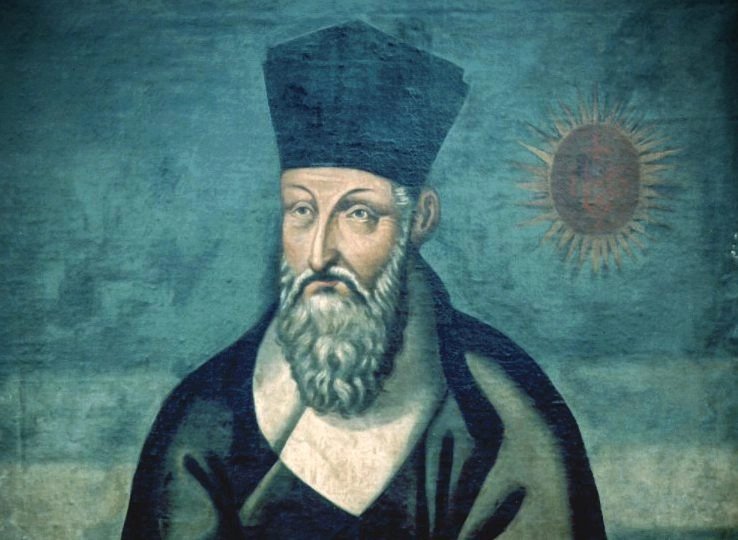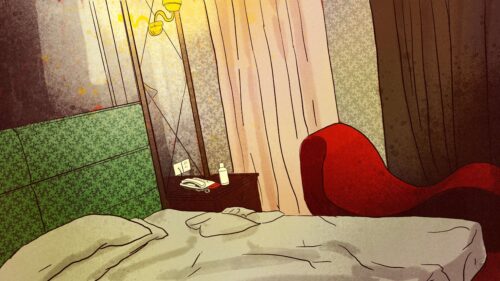This Week in China’s History: August 7, 1582
When Matteo Ricci arrived in Macau on August 7, 1582, it had been more than four years since he left Europe. Sailing from Lisbon to Goa, India, along with a half dozen of his Jesuit brothers, Ricci had stayed in India learning the Chinese language and completing his training in the Society of Jesus. Summoned to China in the winter of 1582, he made his way to Macau. He wasn’t the first Christian missionary in China, nor did he found the Jesuit Mission there, but his name has since become synonymous with West meets East.
Ricci’s name appears on many American college campuses, particularly Jesuit universities like Georgetown, San Francisco, and my own Saint Joseph’s. Buildings, centers or institutes, faculty chairs, dormitory floors, scholarships…anything focused on the study of China or cross-cultural education and learning. In China as well, where he is known as Lì Mǎdòu 利玛窦, the learned Italian priest stands for mutual understanding.
The Jesuit presence in China is often put forward as a model of mutual cultural respect, something in short supply these days. And it is true that the Jesuits engaged with Chinese culture much more genuinely — learning the language and accepting aspects of Chinese culture — than did other Catholic orders. Before the Society was evicted in the 1720s, Jesuits had the ear of both Ming and Qing emperors, and their legacy can be seen in monuments like the Ming observatory in Beijing.
Sadly, the story of that early encounter is one riven with one of the most shameful aspects of the global trading empires that brought Europeans around the world: slavery.
Let’s begin with the setting of Ricci’s arrival: Macau, so close to Hong Kong. The contrast between Hong Kong and Macau is useful, for while Hong Kong represents the 19th- and 20th-century colonialism of the English language and empire, Macau’s connections to Europe are Iberian, and much older. Portugal was the most important European empire for centuries before the English took their place, first arriving at Guangzhou in 1517. For decades, the Portuguese attempted to establish a formal mission to the Ming Dynasty, finally succeeding with the establishment of a base at Macau in 1557.
Whereas the British colony arose out of treaties and leases, Macau’s origins are vague and ad hoc. Portugal did not claim sovereignty over the area — the two islands of Taipa and Coloane — until the 1880s. Before that, the only official agreement was a payment of 500 taels per year, and even that has unclear origins, though by the 1570s it was agreed that Portuguese officials would pay the amount as “rent.”
The clearest definition of the Portuguese presence in Macau during this early period was the Barrier Gate. Built in 1573, the gate was both the boundary and a threat: by closing the gate, Chinese authorities could stop the flow of food and supplies to Macau. On one side of the gate, the Ming Empire, though declining, was one of the world’s largest and most powerful states. On the other side, a precarious community perched at the edge of an empire. This was the world Matteo Ricci entered in 1582, summoned by Jesuit comrade Michele Ruggieri to join the Jesuits’ China mission he had founded.
By the time Ricci arrived, Jonathan Spence tells us in his narrative of Ricci’s life, The Memory Palace of Matteo Ricci, about 10,000 people lived in Macau. About 400 to 500 were Portuguese. Most of the city comprised Chinese families who made their living as part of the growing trade with Europeans. Macau was a pivot between the Portugese trading through Malacca and then to the Indian Ocean, but also the Spanish, whose Galleons, laden with the wealth of the Americas, sailed from Acapulco to Manila, at the edge of the South China Sea.
Alongside global trading systems, a grim reminder of how that world was built was the presence of enslaved laborers, mostly Africans but also people from India, China, Japan, and the Americas. The Lisbon that Ricci had left was one of the world’s centers of the slave trade, and the Portuguese ship that Matteo Ricci sailed on from Mozambique to Goa in 1578 carried several hundred people in bondage along with its cargo, and in Macau, the Jesuit order owned slaves. Enslaved Africans outnumbered Portuguese in Macau by perhaps five to one: of the 10,000 people in Macau when Ricci arrived, perhaps a quarter of them were enslaved.
The Jesuits order itself enslaved Africans, both in India and in Macau. Ricci himself had “black slaves” working for him in Macau.
Some of those enslaved in Macau escaped across the border to China. Because the Jesuits were some of the few Europeans who worked directly in China, they became key elements of the system to capture fugitives. Spence vividly describes not only the extent of the slave economy in and around Macau, but also the Jesuit role in the practice: “Ricci discussed quite openly…his activist role in returning runaway slaves in China to Portuguese authorities in Macau.” He went on, “The Jesuit tactic was to try to identify those fugitive slaves that had been baptized as Christians, and to persuade them that it would better in the long run to return to…resume their lives in the Christian environment of Macau rather than live out their live among the heathen Chinese, especially since the Chinese in any case also ‘treated them just like slaves’.”
Southern China, including Guangzhou, has long been a center of anti-black racism in China. Responses to the COVID-19 pandemic included the demonization of Africans in Guangzhou, and recalled violence against Africans in China during the 1980s and before.
Ricci’s work and that of the other early Jesuits in China had many great successes, with legacies that include a generation of Catholic Chinese, monuments like the great churches of Beijing and other cities, and artifacts like Ricci’s 1602 map, drawn in collaboration with Chinese cartographers, that is the first map to combine Chinese and European mapping knowledge and technology. Ricci’s mastery of the Chinese language and respect to Chinese literary and cultural traditions are worthy of our admiration.
It is certainly too much to lay anti-black racism in China at the feet of the Portuguese in Macau or the Jesuits. It gives pause, though, to consider that the moment in August of 1582 when Ricci — considered by many to be the exemplar of cross-cultural empathy — first entered what is today China, he did so as part of a system of institutional and cultural racism that has endured through the centuries.
This Week in China’s History is a weekly column.






